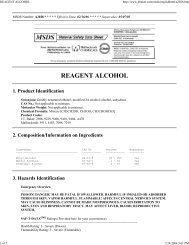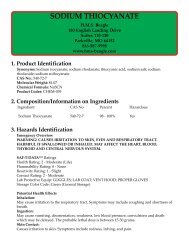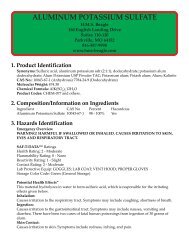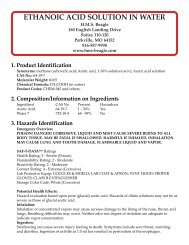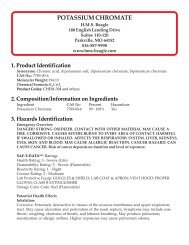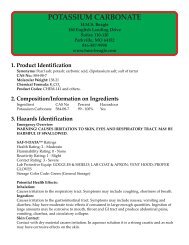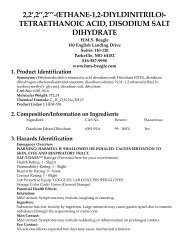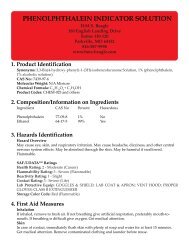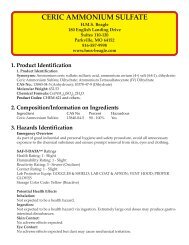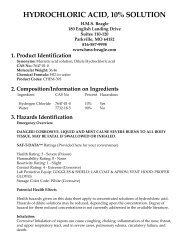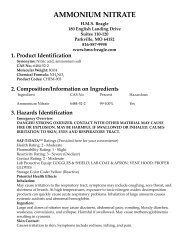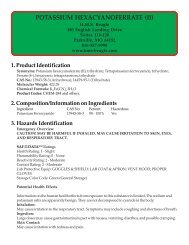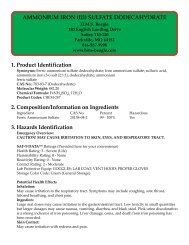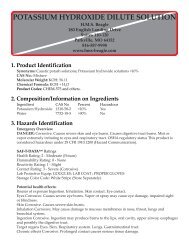COLLODION, FLEXIBLE - HMS Beagle
COLLODION, FLEXIBLE - HMS Beagle
COLLODION, FLEXIBLE - HMS Beagle
- No tags were found...
You also want an ePaper? Increase the reach of your titles
YUMPU automatically turns print PDFs into web optimized ePapers that Google loves.
<strong>COLLODION</strong>, <strong>FLEXIBLE</strong>H.M.S. <strong>Beagle</strong>180 English Landing DriveSuites 110-120Parkville, MO 64152816-587-9998www.hms-beagle.com1. Product IdentificationSynonyms: NoneCAS No.: Not applicable to mixtures.Molecular Weight: Not applicable to mixtures.Chemical Formula: Not applicable to mixtures.Product Codes: CHEM-145-B2. Composition/Information on IngredientsIngredient CAS No Percent HazardousNitrocellulose 9004-70-0 YesDiethyl Ether 60-29-7 60 - 70% YesEthyl Alcohol 64-17-5 YesCamphor 76-22-2 YesCastor Oil 8001-79-4 YesActual concentrations proprietary3. Hazards IdentificationEmergency OverviewDANGER! EXTREMELY FLAMMABLE LIQUID AND VAPOR. HARMFUL IFSWALLOWED, INHALED OR ABSORBED THROUGH SKIN. AFFECTS CENTRALNERVOUS SYSTEM. CAUSES IRRITATION TO SKIN, EYES AND RESPIRATORYTRACT. MAY AFFECT LIVER, BLOOD, REPRODUCTIVE SYSTEM.SAF-T-DATA (tm) Ratings (Provided here for your convenience)Health Rating: 3 - Severe (Life)Flammability Rating: 4 - Extreme (Flammable)Reactivity Rating: 3 - Severe (Explosive)Contact Rating: 2 - Moderate (Life)Lab Protective Equip: GOGGLES & SHIELD; LAB COAT & APRON; VENT HOOD; PROPERGLOVES; CLASS B EXTINGUISHERStorage Color Code: Red (Flammable)Potential Health EffectsInhalation:Vapors have anesthetic properties. Early symptoms of exposure may include irritation of thenose and throat, followed by dizziness and drowsiness. Continued exposure may lead tounconsciousness, respiratory failure, and death.
Ingestion:Harmful if swallowed. May cause headache, stomach pains, and dizziness. Acts as adepressant of the central nervous system and can produce symptoms similar to those ofinhalation exposure. Irritating to the mucous membranes. Ingestion of 1 or 2 ounces may befatal. Because of volatility the stomach becomes distended, which may cause belching. Othersymptoms can include vomiting, unconsciousness, and coma.Skin Contact:Irritating to the skin and mucous membranes by drying effect. Can cause dermatitis onprolonged exposure. May be absorbed through skin.Eye Contact:Vapors may cause irritation. Splashes or high vapor concentrations may produce severeirritation or eye damage.Chronic Exposure:Repeated exposures may be habit forming. Prolonged exposures may result in headache,drowsiness, excitation, and psychic disturbances. The ethyl alcohol component, in repeatedhigh exposures, may cause damage to the liver, blood and reproductive system. Teratogeniceffects are possible for ether and ethyl alcohol.Aggravation of Pre-existing Conditions:Persons with pre-existing skin disorders or eye problems or impaired liver, kidney orrespiratory function may be more susceptible to the effects of this substance. Alcoholicbeverage consumption can enhance the toxic effects of this substance.4. First Aid MeasuresInhalation:Remove to fresh air. If not breathing, give artificial respiration. If breathing is difficult, giveoxygen. Get medical attention.Ingestion:Do NOT induce vomiting. Give large amounts of water. Never give anything by mouth to anunconscious person. Get medical attention.Skin Contact:Wipe off excess material from skin then immediately flush skin with plenty of water for at least15 minutes. Remove contaminated clothing and shoes. Get medical attention. Wash clothingbefore reuse. Thoroughly clean shoes before reuse.Eye Contact:Immediately flush eyes with plenty of water for at least 15 minutes, lifting lower and uppereyelids occasionally. Get medical attention immediately.5. Fire Fighting MeasuresFire:Flash point: < -32C (< -26F)Autoignition temperature: 180 - 190C (356 - 374F)Flammable limits in air % by volume:lel: 1.9; uel: 36.0Extremely Flammable Liquid and Vapor! Vapor may cause flash fire. Very dangerous whenexposed to heat or flame.Listed autoignition temperature and % limits are for Ether.
Explosion:Above the flash point, explosive vapor-air mixtures may be formed. Sealed containers mayrupture when heated. May form explosive peroxides on long standing or after exposure to airor light. May explode when brought in contact with nitric acid. Sensitive to mechanical impact.Sensitive to static discharge.Fire Extinguishing Media:Dry chemical, foam or carbon dioxide. Treat as a flammable gas in a fire situation. Water spraymay be used to keep fire exposed containers cool.Special Information:In the event of a fire, wear full protective clothing and NIOSH-approved self-containedbreathing apparatus with full facepiece operated in the pressure demand or other positivepressure mode. This highly flammable liquid must be kept from sparks, open flame, hotsurfaces, and all sources of heat and ignition. Poisonous gases are produced in fire. Vapors areheavier than air. Liquid floats on water. Both vapor and liquid may travel to source of ignitionand flash back.6. Accidental Release MeasuresVentilate area of leak or spill. Remove all sources of ignition. Wear appropriate personalprotective equipment as specified in Section 8. Isolate hazard area. Keep unnecessary andunprotected personnel from entering. Contain and recover liquid when possible. Use nonsparkingtools and equipment. Collect liquid in an appropriate container or absorb with aninert material (e. g., vermiculite, dry sand, earth), and place in a chemical waste container. Donot use combustible materials, such as saw dust. Do not flush to sewer! US Regulations(CERCLA) require reporting spills and releases to soil, water and air in excess of reportablequantities. The toll free number for the US Coast Guard National Response Center is (800) 424-8802. If a leak or spill has not ignited, use water spray to disperse the vapors, to protectpersonnel attempting to stop leak, and to flush spills away from exposures.J. T. Baker SOLUSORB® solvent adsorbent is recommended for spills of this product.7. Handling and StorageProtect against physical damage. Store in a cool, dry well-ventilated location, away from anyarea where the fire hazard may be acute. Outside or detached storage is preferred. Separatefrom incompatibles. Containers should be bonded and grounded for transfers to avoid staticsparks. Storage and use areas should be No Smoking areas. Use non-sparking type tools andequipment, including explosion proof ventilation. Containers of this material may behazardous when empty since they retain product residues (vapors, liquid); observe allwarnings and precautions listed for the product.8. Exposure Controls/Personal ProtectionAirborne Exposure Limits:-OSHA Permissible Exposure Limit (PEL):400 ppm (TWA) for ether1000 ppm (TWA) for ethyl alcohol2 mg/m3 (TWA) for camphor
-ACGIH Threshold Limit Value (TLV):400 ppm (TWA), 500 ppm (STEL) for ether1000 ppm (STEL), A3 for ethyl alcohol2 ppm (TWA), 3 ppm (STEL), for camphor,A4 Not classifiable as a human carcinogen.Ventilation System:A system of local and/or general exhaust is recommended to keep employee exposures belowthe Airborne Exposure Limits. Local exhaust ventilation is generally preferred because it cancontrol the emissions of the contaminant at its source, preventing dispersion of it into thegeneral work area. Please refer to the ACGIH document, Industrial Ventilation, A Manual ofRecommended Practices, most recent edition, for details.Personal Respirators (NIOSH Approved):If the exposure limit is exceeded and engineering controls are not feasible, a half-face organicvapor respirator may be worn for up to ten times the exposure limit, or the maximum useconcentration specified by the appropriate regulatory agency or respirator supplier, whicheveris lowest. A full-face piece organic vapor respirator may be worn up to 50 times the exposurelimit, or the maximum use concentration specified by the appropriate regulatory agency orrespirator supplier, whichever is lowest. For emergencies or instances where the exposurelevels are not known, use a full-face piece positive-pressure, air-supplied respirator.WARNING: Air-purifying respirators do not protect workers in oxygen-deficient atmospheres.An organic vapor respirator is predicted to have a short service life (less than 30 minutes atconcentrations of ten times the TLV/PEL) when used with this material.Skin Protection:Wear impervious protective clothing, including boots, gloves, lab coat, apron or coveralls, asappropriate, to prevent skin contact.Eye Protection:Use chemical safety goggles and/or a full face shield where splashing is possible. Maintain eyewash fountain and quick-drench facilities in work area.9. Physical and Chemical PropertiesAppearance:Colorless to slightly yellow, syrupy liquid.Odor:Ether-camphor odor.Solubility:Slightly soluble in water.Specific Gravity:0.78pH:No information found.% Volatiles by volume @ 21C (70F):ca. 95Boiling Point:34.6C (95F) (ether)Melting Point:-123C (-189F) (ether)Vapor Density (Air=1):2.6 (ether)
Vapor Pressure (mm Hg):440 @ 20C (68F) (ether)Evaporation Rate (BuAc=1):37.510. Stability and ReactivityStability:Heat, light, and long standing contribute to instability. Reacts with air to form explosiveperoxides. Do not allow the solvents to evaporate from the product. The dry material is shocksensitive.Hazardous Decomposition Products:Burning may produce toxic fumes of cyanide, carbon dioxide, carbon monoxide and oxides ofnitrogen.Hazardous Polymerization:Will not occur.Incompatibilities:Acetyl peroxide, liquid air, bromoazide, chlorine, strong oxidizers, strong acids, strong basesand amines.Conditions to Avoid:Heat, flame, ignition sources, shock, air, sunlight and incompatibles.11. Toxicological InformationToxicological Data:Ether: Oral rat LD50: 1215 mg/kg; inhalation rat LCLo: 32000 ppm/4H; investigated as amutagen, tumorigen. Ethyl alcohol: oral rat LD50: 7060 mg/kg; inhalation rat LC50: 20000ppm/10H; investigated as a tumorigen, mutagen, reproductive effector. Nitrocellulose: oral ratLD50: > 5 gm/kg. Camphor: oral mouse LD50: 1310 mg/kg; investigated as a mutagen. Castoroil: investigated as a tumorigen.Reproductive Toxicity:See Chronic Health Hazards.\Cancer Lists\—NTP Carcinogen—Ingredient Known Anticipated IARC CategoryNitrocellulose (9004-70-0) No No NoneDiethyl Ether (60-29-7) No No NoneEthyl Alcohol (64-17-5) No No NoneCamphor (76-22-2) No No NoneCastor Oil (8001-79-4) No No None
12. Ecological InformationEnvironmental Fate:For ether: When released into the soil, this material is not expected to biodegrade. Whenreleased into the soil, this material is expected to leach into groundwater. When released intothe soil, this material is expected to quickly evaporate. When released into water, this materialis not expected to biodegrade. When released to water, this material is expected to quicklyevaporate. When released into the water, this material is expected to have a half-life of lessthan 1 day. This material has a log octanol-water partition coefficient of less than 3.0. Thismaterial is not expected to significantly bioaccumulate. When released into the air, thismaterial is expected to be readily degraded by reaction with photochemically producedhydroxyl radicals. When released into the air, this material is not expected to be degraded byphotolysis. When released into the air, this material is expected to have a half-life between 1and 10 days.Environmental Toxicity:For ether: This material is not expected to be toxic to aquatic life. The LC50/96-hour values forfish are over 100 mg/l. Environmental Toxicity:For Sodium Bicarbonate:48 hour EC50 Daphnia magna (water flea) : 2350 mg/L.96 hour LC50 Lepomis macrochirus (bluegill) : > 5000 mg/L.120 hour EC50 Nitzschia linearis (diatom) : 650 mg/L.This material is not expected to be toxic to aquatic life.13. Disposal ConsiderationsWhatever cannot be saved for recovery or recycling should be handled as hazardous wasteand sent to a RCRA approved incinerator or disposed in a RCRA approved waste facility.Processing, use or contamination of this product may change the waste management options.State and local disposal regulations may differ from federal disposal regulations. Dispose ofcontainer and unused contents in accordance with federal, state and local requirements.14. Transport InformationDomestic (Land, D.O.T.)Proper Shipping Name: NITROCELLULOSE SOLUTION, FLAMMABLEHazard Class: 3UN/NA: UN2059Packing Group: IIInformation reported for product/size: 320LBInternational (Water, I.M.O.)Proper Shipping Name: NITROCELLULOSE SOLUTION, FLAMMABLEHazard Class: 3UN/NA: UN2059Packing Group: IIInformation reported for product/size: 320LB
15. Regulatory Information————\Chemical Inventory Status - Part 1\————————————————Ingredient TSCA EC Japan AustraliaNitrocellulose (9004-70-0) Yes No Yes YesDiethyl Ether (60-29-7) Yes Yes Yes YesEthyl Alcohol (64-17-5) Yes Yes Yes YesCamphor (76-22-2) Yes Yes Yes YesCastor Oil (8001-79-4) Yes Yes No Yes————\Chemical Inventory Status - Part 2\—————————————————Canada—Ingredient Korea DSL NDSL Phil.Nitrocellulose (9004-70-0) Yes Yes No YesDiethyl Ether (60-29-7) Yes Yes No YesEthyl Alcohol (64-17-5) Yes Yes No YesCamphor (76-22-2) Yes Yes No YesCastor Oil (8001-79-4) Yes Yes No Yes————\Federal, State & International Regulations - Part 1\————————-SARA 302- ———SARA 313———Ingredient RQ TPQ List Chemical Catg.Nitrocellulose (9004-70-0) No No No NoDiethyl Ether (60-29-7) No No No NoEthyl Alcohol (64-17-5) No No No NoCamphor (76-22-2) No No No NoCastor Oil (8001-79-4) No No No No————\Federal, State & International Regulations - Part 2\————————-RCRA- -TSCA-Ingredient CERCLA 261.33 8(d)Nitrocellulose (9004-70-0) No No NoDiethyl Ether (60-29-7) 100 U117 YesEthyl Alcohol (64-17-5) No No NoCamphor (76-22-2) No No YesCastor Oil (8001-79-4) No No NoChemical Weapons Convention: No TSCA 12(b): No CDTA: NoSARA 311/312: Acute: Yes Chronic: Yes Fire: Yes Pressure: NoReactivity: Yes (Mixture / Liquid)Australian Hazchem Code: None allocated.Poison Schedule: None allocated.WHMIS:This MSDS has been prepared according to the hazard criteria of the Controlled ProductsRegulations (CPR) and the MSDS contains all of the information required by the CPR.
16. Other InformationNFPA Ratings: Health: 1 Flammability: 4 Reactivity: 0Label Hazard Warning:DANGER! EXTREMELY FLAMMABLE LIQUID AND VAPOR. HARMFUL IF SWALLOWED,INHALED OR ABSORBED THROUGH SKIN. AFFECTS CENTRAL NERVOUS SYSTEM.CAUSES IRRITATION TO SKIN, EYES AND RESPIRATORY TRACT. MAY AFFECT LIVER,BLOOD, REPRODUCTIVE SYSTEM.Label Precautions:May form explosive peroxides.Keep away from heat, sparks and flame.Avoid breathing vapor.Avoid contact with eyes, skin and clothing.Keep container closed.Use only with adequate ventilation.Wash thoroughly after handling.Store At A Temperature Not Exceeding 30C (86F).DO NOT OPEN Unless Contents Are AtRoom Temperature (72F) or Below For At Least 24 Hours.Label First Aid:If swallowed, DO NOT INDUCE VOMITING. Give large quantities of water. Never giveanything by mouth to an unconscious person. If inhaled, remove to fresh air. If not breathing,give artificial respiration. If breathing is difficult, give oxygen. In case of contact, wipe offexcess material from skin then immediately flush eyes or skin with plenty of water for at least15 minutes. Remove contaminated clothing and shoes. Wash clothing before reuse.Contaminated clothing and shoes should be removed and placed in closed containers forstorage until they can be discarded or cleaned. In all cases, get medical attention.Product Use:Laboratory Reagent and Consumer HobbyRevision Information:No Changes.Disclaimer:************************************************************************************************************H.M.S. <strong>Beagle</strong> and/or Rainbow House Alchemists, LLC, provides the information containedherein in good faith but makes no representation as to its comprehensiveness or accuracy.This document is intended only as a guide to the appropriate precautionary handling of thematerial by a properly trained person using this product. Individuals receiving theinformation must exercise their independent judgment in determining its appropriatenessfor a particular purpose. NEITHER H.M.S. BEAGLE NOR RAINBOW HOUSEALCHEMISTS, LLC MAKE NO REPRESENTATIONS OR WARRANTIES, EITHEREXPRESS OR IMPLIED, INCLUDING WITHOUT LIMITATION ANY WARRANTIES OFMERCHANTABILITY, FITNESS FOR A PARTICULAR PURPOSE WITH RESPECT TOTHE INFORMATION SET FORTH HEREIN OR THE PRODUCT TO WHICH THEINFORMATION REFERS. ACCORDINGLY, H.M.S. BEAGLE AND RAINBOW HOUSEALCHEMISTS, LLC, WILL NOT BE RESPONSIBLE FOR DAMAGES RESULTING FROMUSE OF OR RELIANCE UPON THIS INFORMATION.************************************************************************************************Prepared by: John Farrell KuhnsPhone Number: 816-587-9998 (U.S.A.)



